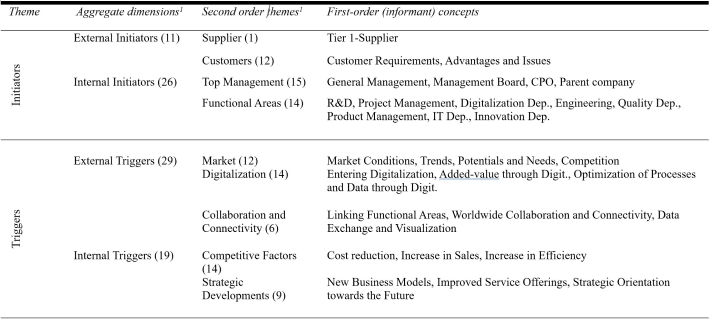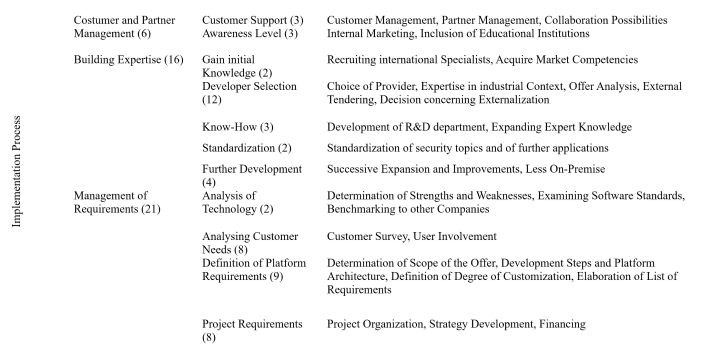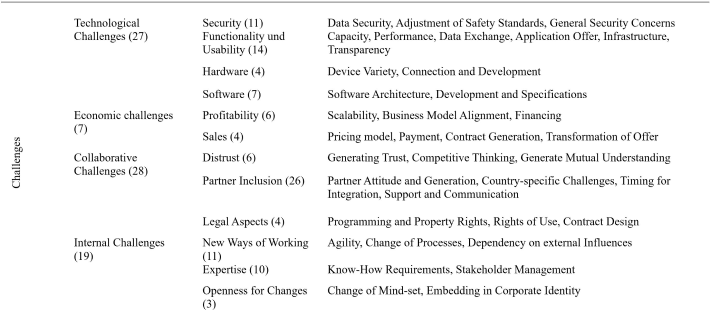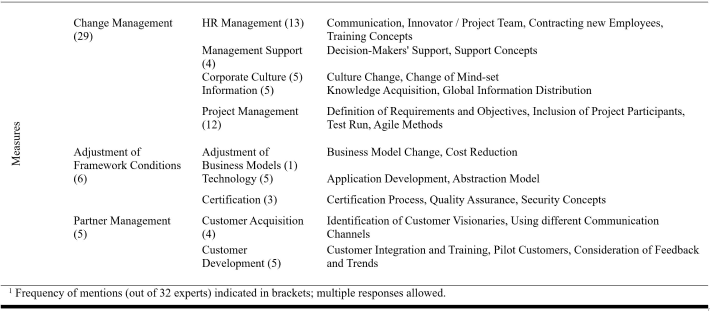AbstractBe brave, be curious, be determined, overcome the odds. It can be done.
Stephen Hawking
Physicist, Cosmologist
Based on digitalization and interconnectedness, Industry 4.0 causes a structural change in the value creation processes, and thus reinforces the transformation of business processes and business models. One way for companies to cope with this development and its associated challenges is to apply digital platforms in the value creation process. As the potential of digital platforms for industrial value creation can only be leveraged to its full extent with adequate implementation, this paper addresses the research question: How are digital platforms best implemented in Industry 4.0 contexts; Using a qualitative case study design, based on 32 semi-structured expert interviews, the study identifies different triggers and initiators, challenges, and respective countermeasures, as thematic core elements of implementation, and requirements for platforms. The research insights contribute to existing literature on Industry 4.0 and digital platforms. In addition, the paper discusses practical implications for industrial companies.
.
1. Introduction
The intention of Industry 4.0, internationally known as the Industrial Internet of Things (IIoT), is to transform industrial value creation into the digital age. Among several other instruments, Industry 4.0 intends to implement digital platforms in the value creation process (Kagermann, Wahlster & Helbig, 2013; Voigt et al., 2018). Platforms have the potential to create ecosystems in which companies interact with partners, customers, and suppliers alike, paving the way for new forms of value creation. In doing so, digital platforms enable a central characteristic of Industry 4.0, which is required to realize horizontal and vertical interconnection across the supply chain (Kagermann, Wahlster & Helbig, 2013; Lasi et al., 2014; Voigt et al., 2018).
Digital platforms act as catalysts for the digital transformation of a company (Hossain & Heidemann Lassen, 2017), which can significantly profit from their great adaptability across industry sectors and value chain stages. Therefore, not only the choice of a product or a technology is crucial, but also the choice of the best platform strategy in combination with the best ecosystem, in order to gain a competitive advantage (Cusumano, 2010). However, little is known about specific changes implied by digital platforms in industrial value creation, regarding the potentials that arise through their application, and especially involving adequate implementation strategies for companies (Parker, Van Alstyne, & Choudary, 2016; Veile et al., 2019; Wiegand et al., 2015).
Given the lack of research on interconnections between Industry 4.0 and digital platforms, alongside of a great interest in research and corporate practice alike, in this paper we address the following research question: “How are digital platforms best implemented in Industry 4.0 contexts?” Further, we give special attention to implementation triggers, requirements concerning platform design, main obstacles that arise, as well as strategies to overcome them.
2. Theoretical Background
Industry 4.0
Industry 4.0 describes a paradigm shift towards a digital and interconnected future of industrial value creation (Lasi et al., 2014; Voigt et al., 2018). It is based on the ex-ante expectation of industrial value creation undergoing a fourth industrial revolution (Kagermann, Wahlster, & Helbig, 2013). Cyber-physical systems form the technological basis of Industry 4.0 and enable real-time interconnectivity in the physical and virtual world along the entire supply chain. This provides the basis for smart data analyses, which entail far-reaching potential. Industry 4.0 is based on the concept of the Internet of Things (IoT), which is why it is also known as the Industrial Internet of Things (Kagermann, Wahlster, & Helbig, 2013; Lasi et al., 2014).
Industry 4.0 addresses current technological developments, such as further automation, digitization, and interconnection of and between machines, people, and products along the entire value chain. This relates to its three main foundations: horizontal interconnection (across the supply chain), vertical interconnection (across company functions), and end-to-end engineering (from production to recycling) (Kagermann, Wahlster, & Helbig, 2013; Lasi et al., 2014). In addition to securing the competitiveness and future viability of the industrial sector, Industry 4.0’s potentials include flexibility and productivity increases, development of new business models, ecological potential, such as reducing energy consumption, and social potential like smoothly integrating people into adaptive working environments (Kagermann, Wahlster, & Helbig, 2013; Müller et al., 2018). However, the concept is also expected to bring several challenges to existing companies, e.g., high costs, endangered existing business models, and fear of employees being replaced (Birkel et al., 2019; Müller & Voigt, 2018).
Digital platforms
A digital platform represents a digital technology-based system infrastructure, business model, and intermediary acting market place that interlinks multiple actors, both internal and external to the company, like customers and suppliers. Based on the quality and quantity of interlinkages, a platform enables communication, interactions, and transaction processes between all connected actors. Digital platforms provide manifold value and advantages, including the ability to reach a wide user base, thereby profiting from high scalability, realizing low transaction costs, and achieving network effects (Gawer & Cosumano, 2014; Hagiu & Wright, 2015).
In general, digital platforms are expected to foster innovation and collaboration between partners, suppliers, and customers by easing communication and coordination among stakeholders (Esposito De Falco, 2017; Xie et al., 2016). Besides this benefit, platforms imply the transformation of existing value chains into digital value creation networks (Kenney & Zysman, 2016). By collecting, analyzing, and using data, these value creation platforms provide the basis for new business models that unite partners, customers, and suppliers on one platform (so-called multi-sided platforms), and thereby serve the goals of several target groups. A change in the value proposition following digital platforms, and involving new products and services, may better serve customer needs and generate additional revenues (Hagiu & Wright, 2015; Müller, Buliga & Voigt, 2018).
Information technology companies have been developing such platforms for years (Gawer & Cusumano, 2002), while the traditional industrial sector, which will be foundationally affected by Industry 4.0, undertakes less efforts in this respect (Parker, Van Alstyne, & Choudary, 2016). It remains that there are hardly any scientific studies examining the effects and implications of digital platforms in industrial application contexts. They refer either to a specific understanding, or to partial aspects of platforms and do not analyze and generate a holistic picture (Boudreau, 2010; de Reuver et al., 2017; Fatorachian & Kazemi, 2018; Parker, Van Alstyne, & Choudary, 2016).
Questions of data ownership, platform control, and power relations between actors within a digital platform, remain unresolved (Boudreau, 2010). Further, digital platforms call for adequate IT competencies, especially for traditional industrial manufacturers (Ravichandran, 2017). It remains a challenge for established enterprises to find partners to develop and set up digital platforms, and thereupon develop new business models (Tiwana & Bush, 2014; Wiegand et al., 2015).
3. Research Design
Method and data collection
Our research approach adopts a multiple case study based on inductively analysed expert interviews (Edmondson & McManus, 2007; Eisenhardt & Graebner, 2007). It is well-suited to examine contemporary and complex phenomena within their real-life contexts (Yin, 2009), along with relatively novel developments at initial stages (Eisenhardt & Graebner, 2007, Yin, 2009). Both aspects are true for platforms in the context of Industry 4.0. Relying on multiple cases increases the robustness and generalizability of the findings as compared to single cases (Eisenhardt & Graebner, 2007).
Following common research practice, the study conducted qualitative research, using semi-structured expert interviews with qualified and experienced managers as the main source of empirical material. This facilitated structured data collection, while still providing the required level of openness in order to allow unexpected and novel knowledge to emerge (Yin, 2009).
Between October 2018 and January 2019, our team interviewed 32 German managers within varying firm sizes and industry sectors. These include information and communication technology (n=14), electronic and electrical engineering (n=8), mechanical engineering (n=4), automotive (n=4), aerospace (n=1), and commercial trade (n=1). The diversity of companies and the heterogeneity of the empirical material counteracts potential negative effects of sample biases on our findings, and follows Yin’s (2009) recommendation for multiple case study sampling.
Data analysis and reliability of the study
After transcribing the 32 audio-recorded interviews, a qualitative content analysis was applied to identify and interpret common patterns, themes, and categories. The developed categories were mainly defined inductively, but were also informed by extant literature (Gioia, Corley, & Hamilton, 2013). Initially, first-order (informant-centric) concepts were developed. These concepts were then synthesized into second-order themes, followed by creating final categories. The entire coding process was conducted as a team in order to achieve as rich interpretations and profound understanding as possible.
Given the research objective, after that, we proceed to evaluate and re-evaluate the results to uncover key findings from the study. To this end, we identified topics with the highest weighted relevance for the study’s interview partners, and examined them against the background of the current state of literature. Finally, we evaluated the results of this procedure as a team to determine our final set of key findings.
4. Results
The Appendix depicts the study’s main results according to the categorization system presented as follows.
Triggers and Initiators
Both of the main roles, triggers and initiators, can be divided into external and internal categories. While triggers are mainly external sources (named by 29 of 32 experts), initiators are prevailingly internal to a company (n=26). We therefore conclude that internal decision-makers generally perceive major external triggers and therefore undertake to initiate implementing a platform.
Among the internal initiators are management (n=15) and functional departments (n=14). Herein, a great variance of departments is notable, as initiators are not only found in engineering or IT, but also in various other departments. A strong interplay between management and operating units concerning initiation is visible as well.
The central external trigger leading to platform initiation is digitalization (n=14), as it provides the technical basis, and prospectively leads to an optimization of processes and data, with increased value added. As well, market factors (n=12) exhibit incentives for digital platforms, which include favourable market conditions for platforms, and competitive pressure. Finally, improved external and internal collaboration and connectivity (n=6) motivates companies to implement platforms.
Internal motivations for companies include prospective improvements in competitive factors (n=14), for example, efficiency gains through digital platforms. Also, internal strategic developments (n=9), as for instance possible new business models, incentivize companies to make a decision in favour of a platform.
Accordingly, in our study, interview partner 16 summarized: “Above all, it's about strategically realigning and meeting the future or the requirements of the future. … It results that it is necessary to support the current business processes, but also to reorganize technologically towards digitalization”. Interview partner 32 amended: “Actually there is not one reason, but a bundle of reasons that lead to the implementation of the platform”.
Platform requirements
Our data shows that expectations towards digital platforms can be of integrative (n=13), economic (n=10), or mainly of a technical nature (n=32). Concerning technical requirements, the salient aspect is functionality (n=13), which comprises a great scattering of concepts like scalability, optimization of different processes and services, various analysis possibilities, and standardization measures. We thus conclude that in corporate practice, companies plan to use platforms for diverse purposes. Therefore, the need for a strong individualization of digital platforms addressing actual practical needs is apparent.
Interview partner 21 confirmed: “And because these are completely different products, the requirements … were of course extremely different. The challenge with this standardization was that we had to combine these extremely heterogeneous requirements from a business point of view in such a way that we could distil a common core. And that was a huge issue.”
In contrast, there is a consensus concerning performance (n=13) and security aspects (n=7). Experts agree that availability, reliability, topicality, data access, and system security are indispensable features. Additionally, platforms are expected to be easily usable (n=6) in terms of operability, personalization, and standardization, to provide comprehensive data processing (n=6), independent of applied software or hardware, and to increase transparency for all participants (n=4).
From an economic point of view, platforms should fulfil expected increase of added value (n=5) by contributing to business models, value creation, and efficiency gains. Eventually, the ratio between platform implementing efforts and benefits should become favourable. In financial terms (n=7), experts want platforms to reveal company cost optimizations through price cuts or staff savings.
Conforming to inherent platform characteristics, integrative requirements include collaboration (n=9) with customers, partners and internally, along with interconnection (n=11) through openness and connectivity over different devices and applications.
Implementation process
The implementation of a digital platform is a complex process, in which manifold approaches, depending on company-specific individual framework conditions, may lead to success. Therefore, abstracting and generalizing the different possible methods to one ideal-typical sequential implementation process is not expedient, and thus not intended in our study. Nevertheless, we find recurring themes in the various approaches and categorize them as core elements of an implementation process. These aspects are customer and partner management (n=6), building up expertise (n=16), management of requirements (n=21), and platform launch (n=28).
Customer and partner management represents an aspect that companies apply throughout the entire implementation processes. It includes supporting partners (n=3) by different collaboration possibilities or trainings, and raising partners’ awareness level concerning the platform (n=3). Another aspect is building up sufficient and adequate expertise. Before implementing a platform, initial knowledge can be gained (n=2) by acquiring market competencies and choosing the right platform developer (n=12). An essential choice to be made in this context is the degree of externalization of development. One factor that potentially influences the implementation success and also the degree of know-how development is previous experience a developer has gained in industrial contexts.
Before the actual launch of a platform, companies generally analyse their specific requirements. They study the technological status quo (n=2) by identifying software standards as well as their own technological strengths and weaknesses. Additionally, customer needs are identified (n=8), for example, through surveys, and the involvement of users in the development process. Hereafter, platform requirements are defined (n=9), and subsequently the platform’s scope and architecture are determined, just as the decision concerning the degree of platform customization. Development steps are then pre-defined. Finally, project requirements are determined (n=8), including among others, financing, organization, and strategy development.
Finally, the actual launch of the platform represents an integral aspect of the platform implementation process. Within this phase, eleven companies first internally prepare to use the platform. This includes preparing the infrastructure, replacing previous models, and undertaking preliminary development of the platform, which is expanded internally to the entire company. In a test phase (n=11), the prototyped platform is internally used, tested, and adapted thoroughly in pilot projects, followed by a pre-launch (n=9). In this phase, companies communicate the upcoming launch to partners, open the platform, and subsequently integrate their partners. During the time of the initial launch (n=3), the exchange of data starts, while possible technical problems are communicated and solved.
Challenges
The main challenges industrial companies perceive when implementing digital platforms are of collaborative (n=28), technological (n=27), company-internal (n=19), and economic (n=7) in nature.
As far as collaboration is concerned, almost all companies are worried about the inclusion of partners (n=26). Especially partner attitudes, for example, insecurity and diverging expectations, but also support and communication, timing, and country-specific aspects, threaten collaboration. Legal aspects (n=4), such as issues of property and rights of use, as well as distrust and scepticism (n=6), mainly caused by competitive thinking, complement the challenges to collaboration.
Internally, in contrast, experts perceive challenges mainly in terms of new approaches to working processes, that are caused by changing procedures, and which platforms reinforce (n=11). Additionally, new expertize (n=10) is needed that results from stakeholder and technical requirements. Likewise, the employee mind-set has to be changed toward a more open organizational culture (n=3).
Among the main technological challenges are aspects concerning functionality and usability (n=14). As already depicted in the platform requirements, platforms entail a high degree of individualization. Therefore, functional challenges differ notably, including performance, data accuracy, and data exchange. Additionally, security issues (n=11) pose major challenges to smooth implementation. Among them are safeguarding data, along with maintaining internal and external safety standards. Likewise, software (n=7) and hardware challenges (n=4) have to be overcome. In this regard, divergent partners' software and hardware specifications and architectures, and consequent development needs and connections play a crucial role.
Finally, seven experts shared with us what economic challenges need to be tackled. These include profitability (n=6) and sales aspects (n=4), wherein financing, scalability, and business model alignment have to be guaranteed. In addition, a company’s offer should be transformed to fit the new digital platform model.
Above all, interview partner 24 emphasised the complexity that arises in platform development: “When I develop specifics for individual customers, I know exactly what is necessary. If I increase the number of customers … then the requests automatically increase.”
Coping with challenges
In order to cope with the discussed challenges, experts propose change management measures (n=29), adjustments of framework conditions (n=6), and partner management (n=5).
Human Resource management (n=13) methods entail elaborating training concepts, and performing transparent and honest communication. Also, contracting new employees as well as initiating and expanding innovator and project teams as driving forces, helps to tackle internal company challenges. Management should be very supportive (n=4), by implementing concepts, for example, to acquire and distribute information and knowledge holistically. Eventually, the platform must be included in all employees’ mind-sets, which requires a change in the overall corporate culture (n=5).
Further, project management measures (n=12) provide support in overcoming execution problems. Requirements and objectives should be clearly defined, and project partners included closely throughout the entire process.
This also affects the framework conditions, which require further adjustment and refinement. For instance, business models should be aligned with the new digital platform strategy. Measures to tackle technological challenges (n=5) include the development of applications in, for example, software and cloud technology.
Finally, partner management helps to cope with integrative challenges. In this way, customer acquisition (n=4) via different communication channels supports the identification of 'customer visionaries'. Customer development (n=5) enhances customer integration into processes. In this context, customer training and pilot customers are beneficial to gather feedback worth considering for further developments.
Summary of key findings
Our study reveals several insights about how to implement digital platforms successfully. The most important findings include:
-
Mainly internal, but also external actors drive the implementation of digital platforms.
-
In contrast, mainly external triggers force companies to apply digital platforms.
-
Technical requirements are the most prominent platform requirements. Further requirements are economic and integrative in nature.
-
Implementation processes differ significantly given a company’s specific characteristics and particular environments. Yet, several similarities can be observed, for example, regarding a platform's launch.
-
Challenges to implementing digital platforms are mostly caused by collaboration and technological issues, which companies can address by applying change management measures.
5. Discussion and Conclusion
Theoretical implications
This paper adds to the sparse literature that has investigated digital platforms and their implementation, linking it with Industry 4.0 (Müller, Buliga & Voigt, 2018; Voigt et al., 2019). In this context, the development of new business models not only poses a challenge toward companies (Tiwana & Bush, 2014; Wiegand et al., 2015), but also offers essential incentives for companies to implement digital platforms (Inoue & Tsujimoto, 2018).
Challenges of digital platforms are in line with general Industry 4.0 risks like endangered existing business models and unclear amortization, given the relatively high costs of implementation (Birkel et al., 2019; Müller & Voigt, 2018). Also, traditional challenges associated with platforms, like questions of data ownership, issues of control, and the power relation between actors within the platform still remain unsolved (Boudreau, 2010). These might be attributed to a lack of trust and the urge to include partners. The development of adequate IT competencies is still a basic requirement, and a central challenge for platform implementation (Ravichandran, 2017). This also includes the integration of customers (Xie et al., 2016), and to fulfil the goals of several customer groups (Hagiu & Wright, 2015; Kiel et al., 2017).
Managerial implications
The results of our research indicate recommendations for management and corporate practice. We propose the following principles should be integrated into corresponding strategies for implementing digital platforms:
-
Information and trends need to be analysed and processed, particularly regarding market developments and competitive factors. In doing so, external triggers can be contrasted with internal competitive and strategic factors to verify individual platform benefits. This implies that, internal initiators from management and functional areas alike play an important role for initiating new developments, and hence should be highlighted and given importance.
-
Before implementing a platform, a thorough analysis of platform requirements should be undertaken. Including and taking on partner and customer perspectives, both internal and external ones, helps to improve specifications. Beside integrative and economic requirements, technical specifications are paramount. Nevertheless, platforms imply scalability and continuing development. Therefore, a continuous improvement approach that includes internal preparation, testing and feedback loops, leads to a smoother platform fit for all actors’ requirements.
-
Change management measures help to ensure a smooth transition into the platform environment. For this purpose, training concepts and communication support the implementation. Management should support the company cultural change by providing sufficient information and funding. These measures should be backed by the adjustment of existing business models and ongoing partner management.
Limitations and further research
Although our results go beyond the mere corporate perspective, by depicting organizational factors that influence individual innovation acceptance, a truly holistic view remains to be investigated. The requirements and challenges identified in this study, suggest benefits and risks of digital platform implementation. However, an investigation of opportunities and ventures, especially concerning a sustainable integration of digital platforms into business routines, would amend our results. Finally, we discussed that digital platforms, just like Industry 4.0, impact value creation profoundly, and thus have major implications for traditional business models. The nature and structure of these implications caused by such platforms, remains to be uncovered.
Considering the comparable novelty of the research area, it is noteworthy that many of the examined companies have only been dealing with the topic of digital platforms for a short period of time. Consequently, many changes are just emerging in the course of Industry 4.0 implementation. Hence, the study’s results cover only the current state of the field, still prior to a consolidated use of digital platforms in industrial practice, and should be closely accompanied in future research. Accordingly, this study provides valuable insights into current initiators, requirements, processes and challenges of platform implementation, which should be re-confirmed at a later point of development.
Appendix
Table of Results
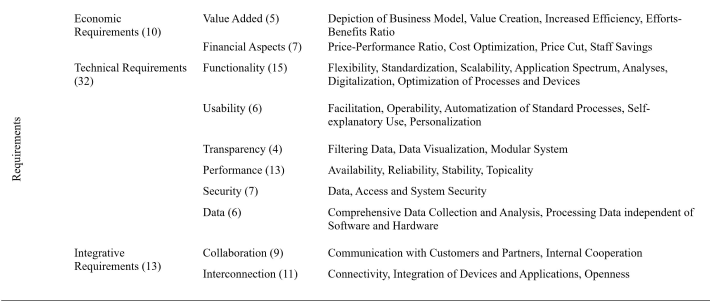
References
Birkel, H. S., Veile, J. W., Müller, J. M., Hartmann, E., & Voigt, K.-I. 2019. Development of a risk framework for Industry 4.0 in the context of sustainability for established manufacturers. Sustainability, 11(2): 384.
Boudreau, K. 2010. Open Platform Strategies and Innovation: Granting Access vs. Devolving Control. Management Science 56(10): 1849-1872.
Cusumano, M. 2010. The Evolution of Platform Thinking. Technology Strategy and Management, 53(1): 32–34.
De Reuver, M., Sørensen, C., & Basole, R.C. 2017. The Digital Platform: A Research Agenda. Journal of Information Technology: 1-12.
Edmondson, A.C., & McManus, S.E. 2007. Methodological Fit in Management Field Research. Academy of Management Review 32(4): 1246-1264.
Eisenhardt, K.M, & Graebner, M.E. 2007. Theory Building from Cases: Opportunities and Challenges. Academy of Management Journal 50(1): 25-32.
Esposito De Falco, S., Renzi, A., Orlando, B., & Cucari, N. 2017. Open Collaborative Innovation and Digital Platforms. Production Planning & Control 28(16): 1344-1353.
Fatorachian, H., & Kazemi, H. 2018. A Critical Investigation of Industry 4.0 in Manufacturing: Theoretical Operationalisation Framework. Production Planning & Control: 1-12.
Gawer, A., & Cusumano, M.A. 2002. Platform Leadership: How Intel, Microsoft, and Cisco drive industry innovation. Boston: Harvard Business School.
Gawer, A., & Cusumano, M.A. 2014. Industry Platforms and Ecosystem Innovation. Journal of Product Innovation Management 31(3): 417-433.
Gioia, D.A., Corley, K.G., & Hamilton, A.L. 2013. Seeking Qualitative Rigor in Inductive Research: Notes on the Gioia Methodology. Organizational Research Methods 16(1): 15-31.
Hagiu, A., & Wright, J. 2015. Multi-Sided Platforms. International Journal of Industrial Organization 43: 162-174.
Holsti, O.R. 1968. Content Analysis. In G. Lindzey, & E. Aronson (Eds.) The Handbook.
Hossain, M. & Heidemann Lassen, A. 2017. Q&A. How do digital platforms for ideas, technologies, and knowledge transfer acta s enablers for digital transformation? Technology Innovation Management Review 7(9): 55-60.
Inoue, Y., & Tsujimoto, M. 2018. Genres of Complementary Products in Platform-Based Markets: Changes in Evolutionary Mechanisms by Platform Diffusion Strategies. International Journal of Innovation Management 22(1): 1850004.
Kagermann, H., Wahlster, W., & Helbig, J. 2013. Recommendations for Implementing the Strategic Initiative Industrie 4.0 – Final Report of the Industrie 4.0 Working Group. Frankfurt am Main: Communication Promoters Group of the Industry-Science Research Alliance, acatech.
Kenney, M., & Zysman, J. 2016. The Rise of the Platform Economy. Issues in Science and Technology 32(3): 61-69.
Kiel, D., Müller, J.M., Arnold, C., & Voigt, K.I. 2017. Sustainable Industrial Value Creation: Benefits and Challenges of Industry 4.0. International Journal of Innovation Management 21(8): 1740015.
Lasi, H., Fettke, P., Kemper, H., Feld, T., & Hoffmann, M. 2014. Industry 4.0. Business & Information Systems Engineering 6(4): 239-242.
Müller, J. M., Buliga, O., & Voigt, K.-I. 2018. Fortune Favors the Prepared: How SMEs Approach Business Model Innovations in Industry 4.0. Technological Forecasting and Social Change, 132: 2-17.
Müller, J.M., & Voigt, K.-I. 2018. Sustainable industrial value creation in SMEs: A comparison between industry 4.0 and made in China 2025. International Journal of Precision Engineering and Manufacturing-Green Technology, 5(5): 659-670.
Parker, G., Van Alstyne, M., & Choudary, S.P. 2016. Platform Revolution: How Networked Markets are Transforming the Economy and How to Make Them Work for You. New York: Norton and Company.
Ravichandran, T. 2017. Exploring the Relationships Between IT Competence, Innovation Capacity and Organizational Agility. The Journal of Strategic Information Systems 27(1): 22-42.
Tiwana, A., & Bush, A.A. 2014. Spotting Lemons in Platform Markets: A Conjoint Experiment on Signaling. IEEE Transactions on Engineering Management 61(3): 393-405.
Veile, J. W., Kiel, D., Müller, J. M., & Voigt, K. I. 2019. Lessons learned from Industry 4.0 implementation in the German manufacturing industry. Journal of Manufacturing Technology Management, in press, available online.
Voigt, K.-I., Arnold, C. Kiel, D., & Müller, J.M. 2019. Geschäftsmodelle im Wandel durch Industrie 4.0 – Wie sich etablierte Industrieunternehmen in verschiedenen Branchen verändern. In: Handbuch Industrie 4.0. Wiesbaden: Springer Gabler: 355-378.
Voigt, K.-I., Kiel, D., Müller, J.M., & Arnold, C. 2018. Industrie 4.0 aus Perspektive der nachhaltigen industriellen Wertschöpfung. In: Digitalisierung im Spannungsfeld von Politik, Wirtschaft, Wissenschaft und Recht. Berlin, Heidelberg: Springer Gabler: 331-343.
Wiegand, N., Witt, S., Steiner, M., & Backhaus, K. 2015. Platform Adoption in Network Markets: Selecting Beneficial Partners to Achieve Market Dominance. International Journal of Innovation Management 19(2): 1550028.
Xie, K., Wu, Y., Xiao, J., & Hu, Q. 2016. Value Co-Creation between Firms and Customers: The Role of Big Data-Based Cooperative Assets. Information & Management 53(8): 1034-1048.
Yin, R.K. 2009. Case Study Research: Design and Methods. Thousand Oaks, CA: Sage.
Keywords: Buyer-Supplier Relationships, collaboration, digital platforms, Digital Technologies., IIoT, Industry 4.0, Supplier Integration

